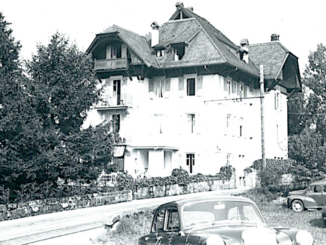In the summer of 1932, my grandfather and his pregnant wife set off in a motorcycle and sidecar for a motoring tour of North Wales. In our last episode we recalled their stop in Liverpool. This time they have reached Chester.
Chester Cathedral
Chester Cathedral is a Church of England cathedral, is the mother church of the Diocese of Chester and has been the seat of the Bishop of Chester since 1541. Originally an abbey church dedicated to Saint Werburgh, the cathedral is now a Grade I listed building showcasing various architectural styles from the 10th to the early 16th century.

© Always Worth Saying 2023, Going Postal
The oldest parts of the cathedral date back to 1093, when it began its life as a Benedictine Abbey. Over the centuries, the structure has undergone various modifications, combining Norman, Gothic, and Perpendicular styles. Unique features of the cathedral include a bishop’s consistory court and a separate parish church within its premises.
These days, beyond being a place of worship, Chester Cathedral serves as a vibrant community hub hosting a range of events. These include unconventional activities like abseiling, modern art exhibitions, this author’s second oldest son’s university graduation and Pete Waterman’s 64-foot-long model railway based upon Milton Keynes Central. Choir stalls feature intricately carved misericords with imaginative creatures and the nave is occasionally used as an indoor/outdoor cinema.
The Baptistry houses a stone plinth with the board of an ancient game called ‘nine men’s morris’. The cathedral’s rich history and exceptional architecture make it a must-see attraction in Chester.
Chester in the 1930s
Chester in the 1930s was a city transitioning from its industrial past towards a more service-oriented economy. It was a period marked by the Great Depression, which also affected Chester, though the city’s diverse economic base helped to cushion the blow. In terms of infrastructure, the city saw significant developments during this decade. The renowned Chester Zoo was opened in 1931 by George Mottershead and has since become one of the city’s most popular attractions. The Grosvenor Bridge, a vital transport link across the River Dee, was already in place and celebrating its centenary.
The city retained much of its historical charm, with its Roman and medieval walls still standing, along with the unique Rows – two-tiered shopping galleries dating from the Middle Ages. Culturally, Chester was and still is home to several theatres, including the Chester Little Theatre, which began its operations in the 1920s and continued to thrive in the 1930s, hosting a variety of performances. However, the 1930s were also a period of global upheaval with the approach of World War II, and Chester, like the rest of Britain, would soon find itself drawn into the conflict.
Upon leaving Chester we reach Welsh Wales which during the 1930s was also experiencing a period of transition and growth. As with much of the world, North Wales was grappling with the economic fallout of the Great Depression at the start of the decade. However, its strategic position and unique natural resources allowed the region to recover. Major industries during this time included coal mining, slate quarrying, and agriculture, which provided jobs and contributed to the local economy. Additionally, as we shall see, the 1930s saw an increase in tourism, with people being attracted to the beautiful landscapes and historical sites. One of which is Conway.
Conway
Conway, also spelt Conwy, is a historic town known for its well-preserved medieval structures. The town is recognized for Conwy Castle, a prominent ancient landmark which sits on a grassy landscape. The castle is characterized by its fortified structure and distinctive circular towers. Situated within the Snowdonia National Park, Conwy is also a gateway to exploring the natural beauty of Wales. Whether you’re interested in history, architecture, or outdoor activities, Conwy offers a unique blend of experiences.

© Always Worth Saying 2023, Going Postal
Pictured on the far side, the Conway Bridge, also known as the Conwy Railway Bridge, is a remarkable piece of 19th-century engineering, designed by Robert Stephenson. This Grade I listed, wrought-iron tubular bridge is the last of its kind after the original Britannia Bridge (which crosses the Menai straights at Bangor) was destroyed and rebuilt. The bridge, which started construction in 1846 and officially opened in 1849, was initially intended to be a suspension bridge. However, it was redesigned as a box-girder structure to accommodate trains. The pylons at either end were crafted to echo the castle walls of neighbouring Conwy Castle which the road bridge leads to and the railway line skirts to the south.
On the near side sits the original Conway Road bridge, a Thomas Telford suspension bridge and also a Grade I-listed structure. This was built between 1822 and 1826 as one of the world’s first suspension bridges. It was superseded by another road bridge built slightly to the west and opened in 1958 – 26 years after my grandparent’s visit. None of these bridges span the entire width of the River Conway (which at this point is several hundred yards wide) but rather cross a channel through a causeway that leads from the northern bank of the river at Llandudno.
Since 1965, the Telford Bridge has been under the ownership of The National Trust. Despite its historical significance, the bridge has been identified as inadequate for modern traffic due to its age and is only crossable on foot. The old photo is taken from a wall adjoining the road from the old road bridge which we can’t quite get to on Street View. But Puffins can scout about via this link.
Menai Straights Bridge
As we continue around the coast for another 12 miles we reach Bangor and the Menai Straights which are a narrow stretch of tidal water about 15 miles long which separate the island of Anglesey from the mainland of Wales. It is known for its strong currents, making it a challenging route for sailors. Its shores are lined with beautiful and diverse landscapes, from woodlands and small islands to cliffs and mountains. The strait is spanned by two iconic bridges, the Menai Suspension Bridge, designed by Thomas Telford, and the Britannia Bridge, designed by Robert Stephenson. Both bridges are celebrated feats of 19th-century engineering. The Menai Strait is also a designated Special Area of Conservation, hosting a variety of marine and birdlife.

© Always Worth Saying 2023, Going Postal

© Google Street View 2023, Google.com
The Menai Suspension Bridge pictured above was completed in 1826 to a design by the renowned engineer Thomas Telford. It was the world’s first modern suspension bridge and was considered a marvel of its time due to its innovative iron chain-link construction. The bridge stands at a height of about 100ft above the strait, allowing ships to pass beneath it. It remains an important transport link and a symbol of Welsh engineering prowess. Today, it’s maintained by the Welsh Government and is used by both pedestrians and vehicles.
The sign in the old photograph reads, ‘Notice. Drivers leaving vehicles about this road will be prosecuted’. The war against the motorist is a long one! Today the road is different with a roundabout putting paid to the original wall and hedge. However, although hidden in the Street View image the building with the distinctive chimney stack remains. This is Telford House although its connection with the great man seems to be no more than in providing a view of the Eskdale-born engineer’s masterpiece. You can have a look around via this link.
Caernarfon Castle
Only six miles further along the straights and facing Anglesey sits Caernarfon. Often anglicized as Caernavon, this is a royal town and port in the county of Gwynedd. The town is renowned for its majestic Caernarfon Castle, a UNESCO World Heritage Site, which was built by King Edward I in the 13th century as one of the ‘iron ring’ of fortresses to subdue the Welsh. Caernarfon’s historic town walls, narrow streets, and colourful waterfront make it a popular tourist destination. It also holds historical significance as the location for the investiture of the Prince of Wales.

© Always Worth Saying 2023, Going Postal

© Google Street View 2023, Google.com
In the modern day you can stand in exactly the same spot as my grandparents almost a century ago, even to the point of being behind the same two-bar iron fence.
There is more traffic both on the roads and on the River Seiont. A harbourside crane is visible in the old photo. To the left, the building next to the castle is the old courthouse and next to that can be seen the Anglesey hostelry which has since been covered in white rendering and over-thick black detailing. Yuk.
Lake Dinas
From Caernavon we head inland on the A4085 as far as Beddgelert before heading northeast on the A498 bound for Snowdon. En route we reach Lake Dinas, or Llyn Dinas, a beautiful and tranquil lake located in the heart of Snowdonia National Park. It covers an area of 60 acres and is known for its stunning natural beauty, including the surrounding mountains and the lush woodland on its shores. The lake’s name stems from the nearby Dinas Emrys, a historic and legendary hill fort. The area around Lake Dinas is rich in Welsh history and folklore, making it a fascinating destination for both nature lovers and history enthusiasts.

© Always Worth Saying 2023, Going Postal

© Google Street View 2023, Google.com
The old photo was taken from a slight layby north of the lake which is still there and allows the nineteen-thirties view of the reassuringly timeless landscape to be replicated.
Next time: Snowdon
© Always Worth Saying 2023



